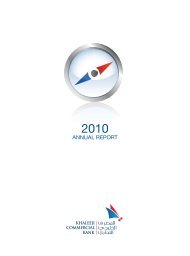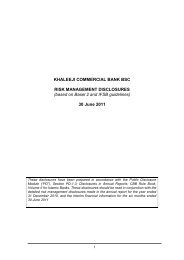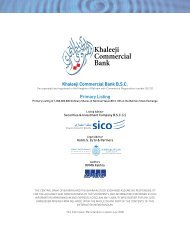2011 Annual Report - Khaleeji Commercial Bank BSC
2011 Annual Report - Khaleeji Commercial Bank BSC
2011 Annual Report - Khaleeji Commercial Bank BSC
You also want an ePaper? Increase the reach of your titles
YUMPU automatically turns print PDFs into web optimized ePapers that Google loves.
KHALEEJI COMMERCIAL BANK <strong>BSC</strong><br />
RISK MANAGEMENT DISCLOSURES<br />
1. Group Structure<br />
The <strong>Bank</strong> operates under a retail banking license granted by the CBB on 20 October 2003. The <strong>Bank</strong> does not have significant<br />
operating subsidiaries. The subsidiaries set-up is primarily special purpose entities with nominal capital to execute specific<br />
investment transactions. The subsidiaries qualify as commercial entities as per the CBB guidelines and are risk weighted as<br />
investments for capital adequacy computation purposes.<br />
2. Introduction to Basel II & Risk Management<br />
The CBB has mandated that the Basel Committee on <strong>Bank</strong>ing Supervision’s (“Basel Committee”) Basel II capital adequacy<br />
framework is applicable to all banks incorporated in the Kingdom of Bahrain from 1 January 2008. The <strong>Bank</strong> has accordingly<br />
taken steps to comply with these requirements. The Basel II framework is intended to strengthen risk management practices<br />
and processes within the financial institutions.<br />
CBB’s capital adequacy framework is based on three pillars, consistent with the Basel II framework adopted by the Basel<br />
Committee, as follows:<br />
• Pillar I: calculation of the risk weighted assets (RWAs) and capital requirement.<br />
• Pillar II: the supervisory review process, including the Internal Capital Adequacy Assessment Process (ICAAP).<br />
• Pillar III: rules for disclosure of risk management and capital adequacy information.<br />
Pillar I<br />
Pillar I defines the regulatory minimum capital requirements for each bank to cover the credit risk, market risk and operational<br />
risk inherent in its business model. It also defines the methodology for measurement of these risks and the various elements<br />
of qualifying capital. The capital adequacy ratio is calculated by dividing the regulatory capital base by the total Risk Weighted<br />
Assets (“RWAs”). CBB has mandated that the ratio be maintained at a minimum of 12% and has set a trigger ratio of 12.5%.<br />
If the capital adequacy ratio falls below 12.5%, additional prudential reporting requirements apply, and a formal action plan to<br />
restore the ratio above the trigger level is to be formulated and submitted to the CBB.<br />
The table below summarizes the Pillar I risks and the approach used by the <strong>Bank</strong> to calculate the RWAs in each case in<br />
accordance with the CBB’s Basel II capital adequacy framework:<br />
Risk Type<br />
Credit Risk<br />
Market Risk<br />
Operational Risk<br />
approach used by KHCB<br />
Standardised Approach<br />
Standardised Approach<br />
Basic Indicator Approach<br />
Pillar II<br />
Pillar II defines the process of supervisory review of an institution’s risk management framework and, ultimately its capital adequacy.<br />
Pillar II comprises two processes:<br />
• An Internal Capital Adequacy Assessment Process (ICAAP), and<br />
• A supervisory review and evaluation process.<br />
Risk Management Disclosures<br />
81










